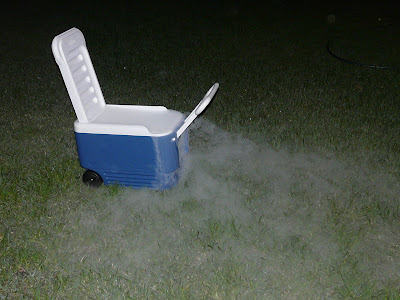In this on-going series on wake turbulence, I've been showing you the various heavy jets that we see at LAX. But for every rule, there's at least one exception (it's a rule). This time around, we're going to look at the exceptions. There are two that affect us here at LAX, and each of them features a different model of aircraft.
First is the 525-passenger Airbus A380, the largest passenger airliner in the world. Compare its maximum takeoff weight of 1,200,000 lb (560,000 kg) to that of the freighters in the
previous entry in the series, and the next-largest airliner, the
Boeing B747-400.
This airplane's huge weight disparity with everything else has earned it a separate moniker. Whereas we refer to all the other heavy jets as "heavies", the A380 is referred to as a "Super". Examples:
"Qantas 94 Super"
"Super Airbus 380"
Besides the uprated terminology, the A380 also imposes additional separation requirements. Similar to the Heavy wake turbulence spacing requirements, the mileage required behind the Super is determined by the size of the following aircraft. Another Super
only needs four (4) miles in trail, while a heavy jet requires six (6) miles behind a Super. A "Large" aircraft, which is is defined in
Appendix A of the
7110.65 as one weighing more than 41,000 lbs and up to 255,000 lbs, has to be at least
eight (8) miles behind a Super. Typical Larges include B737's, MD-80's, the A320 series, and regional jets. An aircraft of less than 41,000 lbs is considered a "Small", and must have at least
ten (10) miles of separation behind a Super. At LAX right now, the most common Smalls are the United Express E-120 Brasilias, along with most of the corporate aircraft such as Learjets, Citations, and King Airs. Operationally, the Super poses other difficulties at LAX: When one is on a taxiway, the wings overhang the vehicle service roads, thus requiring any Super movement to be accompanied by airport operations escorts, who block off the service roads in much the same manner as funeral escorts. And, like its smaller A340-600 cousin, there are only certain taxiways and intersections that the A380 can use - Except that the A380 can use even fewer than the A346 (and B773). There aren't as many gates that can accommodate the A380 either; I think we have six right now, and only two of those at a terminal. Fortunately, Qantas is the only carrier bringing them into LAX at present, and so far I don't think we've had more than two here at once. We do keep hearing rumors of other carriers with plans to start using them here; Singapore, Lufthansa, and Virgin Atlantic are the names I've heard mentioned most often. And if all that isn't enough, Airbus has plans for a stretched model, which would have a standard (3-class) seating capacity of 650!
UPDATE: The wake turbulence spacing behind a Super has been revised to six (6) miles in trail for another Super or a Heavy; seven (7) miles in trail for a Large, and eight (8) miles for a small. See this post for a quick reference.

One of my best shots: A Qantas A380 touches down on runway 24 left.

Mutt and Jeff: the largest and smallest of the airliners at LAX. An Emirates A380, here on a publicity tour, and a United Express (Skywest) E-120 Brasilia.
UPDATE: The following section is now obsolete; the B757, regardless of model or weight, is no longer considered a Heavy. See this entry.
Exception number two: The Boeing 757-200. This particular aircraft is an anomaly (and a pain in the @$ for controllers); it's not a heavy, and yet it has its own wake turbulence requirements. Whereas a Large aircraft behind another Large aircraft requires three (3) miles of spacing, a Large behind a B752 needs four (4) miles. That same Large needs five (5) miles behind a heavy jet. However, it gets even better: As I mentioned early on, the FAA defines any aircraft capable of operating at a weight of more than 255,000 lbs as a Heavy. There is one variant of the B757-200 that has a maximum weight of 255,500 lbs, and thus
is a heavy. As far as I know, there is no visible differentiation between a heavy B757 and one that isn't a heavy. The paperwork is the only way to tell the difference. Fortunately for us, only two airlines at LAX operate the "heavy" version; unfortunately, both also have non-heavies. Oh, and there's one other minor detail: A quirk of our flight plan computer keeps the airlines from correctly filing the heavy B752's as "Heavies"; it just won't let them do it. Controllers
can put it in as an amendment though, and so the Clearance Delivery controller gets to play a question-and-answer game with all the pilots of the out-going B757-200 flights for US Air and American: "Are you a heavy today?" Sort of like going to McDonald's: "Would you like to supersize today?" It doesn't take much imagination to see the possibility for this system to go awry. There have been cross-country separation errors caused by an aircraft's heavy status being missed at the departure point; a solution is in the works, which I've heard will be effective this spring.

Is it a heavy, or isn't it? In this case, a definite 'yes' for the B762 on the taxiway; and 'maybe, maybe not' for the B752 on the runway: American has both.
The flight crew knows, and hopefully so do we . . .

Is it a heavy, or isn't it? In this case, 'yes' for the gray B763; and 'no' for the white B752.
United doesn't operate heavy B757-200's.

Continental's B752's are not heavies.

Nor are Delta's.

But this one might be: US Air has a few B752's that qualify as heavies.






































